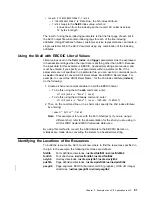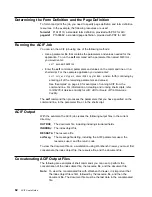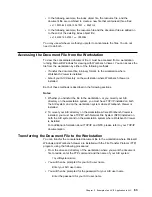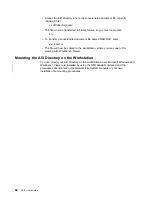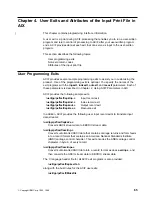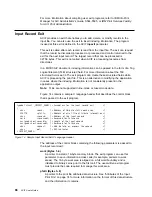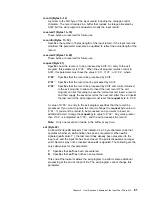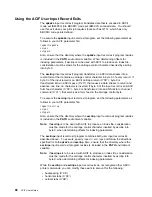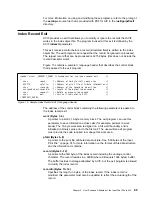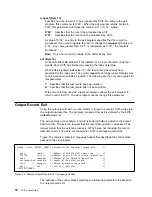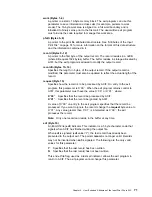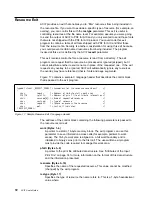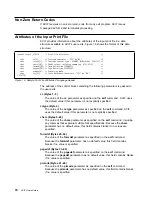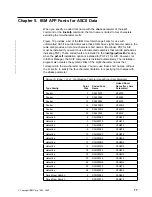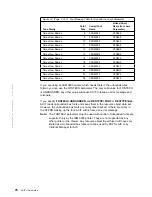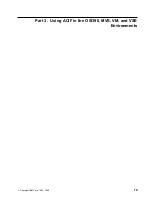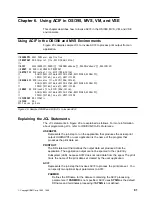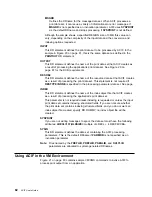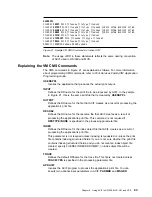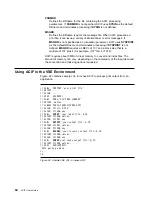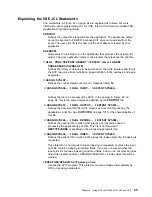
work (Bytes 1–4)
A pointer to a static, 16-byte memory block. The exit program can use this
parameter to save information across calls (for example, pointers to work
areas). The 16-byte work area is aligned on a full word boundary and is
initialized to binary zeros prior to the first call. The user-written exit program
must provide the code required to manage this work area.
pfattr (Bytes 5–8)
A pointer to the print file attribute data structure. See “Attributes of the Input
Print File” on page 74 for more information on the format of this data structure
and the information contained in it.
record (Bytes 9–12)
A pointer to the first byte of the output record. The record resides in a 32KB
(where KB equals 1024 bytes) buffer. The buffer resides in storage allocated by
ACIF, but the exit program is allowed to modify the output record.
recordln (Bytes 13–14)
Specifies the length, in bytes, of the output record. If the output record is
modified, this parameter must also be updated to reflect the actual length of the
record.
request (Byte 15)
Specifies how the record is to be processed by ACIF. On entry to the exit
program, this parameter is X
'
00
'
. When the exit program returns control to
ACIF, this parameter must have the value X
'
00
'
or X
'
01
'
, where:
X
'
00
'
Specifies that the record be processed by ACIF.
X
'
01
'
Specifies that the record be ignored by ACIF.
A value of X
'
00
'
on entry to the exit program specifies that the record be
processed. If you want to ignore the record, change the request byte value to
X
'
01
'
. Any value greater than X
'
01
'
is interpreted as X
'
00
'
; the exit
processes the record.
Note: Only one record can reside in the buffer at any time.
eof (Byte 16)
An End-Of-File (eof) indicator. This indicator is a 1-byte character code that
signals when ACIF has finished writing the output file.
When eof is signaled (eof value=‘Y’), the last record has already been
presented to the output exit. The pointer record is no longer valid. Records
may not be inserted when eof is signaled. The following are the only valid
values for this parameter:
Y
Specifies that the last record has been written.
N
Specifies that the last record has not been written.
This end-of-file flag, used as a last-call indicator, allows the exit program to
return to ACIF. The exit program cannot change this parameter.
Chapter 4. User Exits and Attributes of the Input Print File in AIX
71
Содержание S544-5285-01
Страница 1: ...IBM Print Services Facility IBM AFP Conversion and Indexing Facility User s Guide S544 5285 01...
Страница 2: ......
Страница 3: ...IBM Print Services Facility IBM AFP Conversion and Indexing Facility User s Guide S544 5285 01...
Страница 10: ...viii ACIF User s Guide...
Страница 21: ...Part 1 Information Common to AIX OS 390 MVS VM and VSE Environments Copyright IBM Corp 1993 1999 1...
Страница 22: ...2 ACIF User s Guide...
Страница 40: ...20 ACIF User s Guide...
Страница 41: ...Part 2 Using ACIF in the AIX Environment Copyright IBM Corp 1993 1999 21...
Страница 42: ...22 ACIF User s Guide...
Страница 72: ...52 ACIF User s Guide...
Страница 96: ...76 ACIF User s Guide...
Страница 99: ...Part 3 Using ACIF in the OS 390 MVS VM and VSE Environments Copyright IBM Corp 1993 1999 79...
Страница 100: ...80 ACIF User s Guide...
Страница 106: ...86 ACIF User s Guide...
Страница 134: ...Figure 24 Example of a Customer s Phone Bill 114 ACIF User s Guide...
Страница 142: ...122 ACIF User s Guide...
Страница 196: ...176 ACIF User s Guide...
Страница 197: ...Part 4 Appendixes Copyright IBM Corp 1993 1999 177...
Страница 198: ...178 ACIF User s Guide...
Страница 206: ...186 ACIF User s Guide...
Страница 210: ...190 ACIF User s Guide...
Страница 226: ...206 ACIF User s Guide...
Страница 253: ......
Страница 255: ...Spine information IBM IBM Print Services Facility User s Guide AFP Conversion and Indexing Facility...





